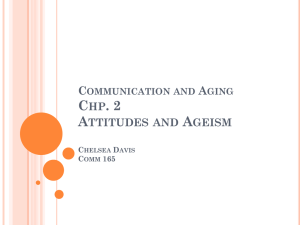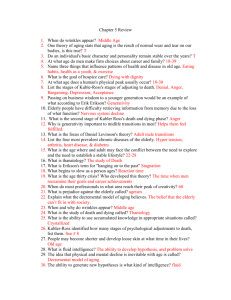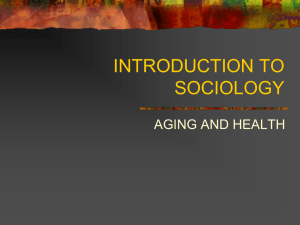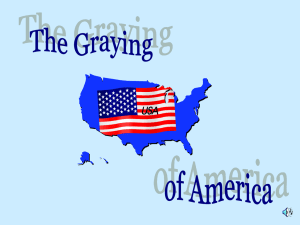the aging journey - Shepherd Webpages
advertisement
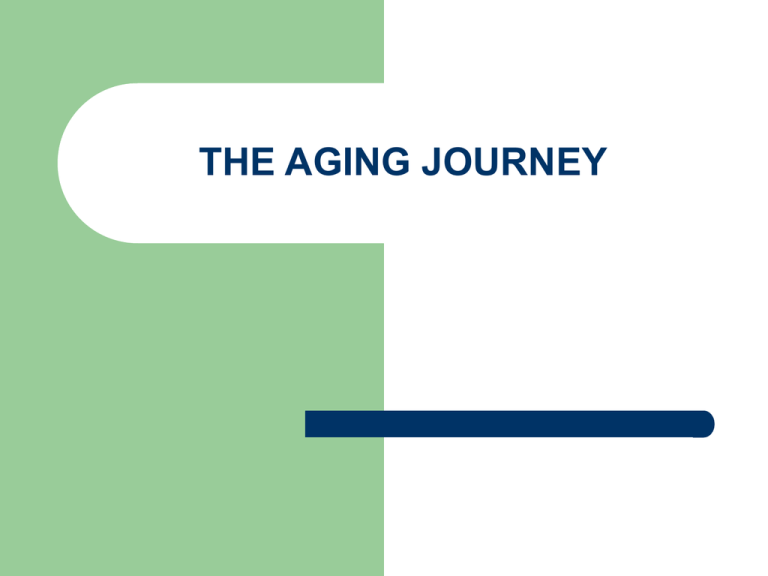
THE AGING JOURNEY Aging and Leisure: Misunderstood? AGING: typically viewed as a largely undesirable period of life during which a series of physical, cognitive, social, and emotional declines occur. LEISURE: seen as somewhat frivolous and certainly secondary to the more serious business of life. A Positive Perspective On Aging “The progress of gerontology began to stall in the mid-1980’s…There was a persistent preoccupation with disability, disease, and chronological age, rather than the positive aspects of aging”. The term “Ulyssean Adult” was coined to identify individuals who continue to seek new adventures and opportunities in their later years. The prototype for such an individual comes from Ulysses, who was more than 50 years of age when his adventures in the Odyssey began and more than 70 when he began his last voyage. SOCIAL ASPECTS OF AGING Changes in Social Roles Social Responses to Aging Negative Stereotypes Positive Stereotypes Negative Attitudes Positive Attitudes Negative Discrimination Positive Discrimination Changes in Social Roles Every individual lives in a social context that influences his or her behavior! The process of socialization that is the process through which we absorb values, beliefs, and knowledge that guide our behavior as a member of a social group. Cont. As young people we are directly or indirectly instructed to behave in ways that conform to the norms created within our social group We learn to conform We assume certain roles We have social expectations How do social norms and roles change as we age? Social Responses To Aging What do you see when you first meet someone? How do you evaluate someone when you first meet them? Do you judge someone when you first meet them? How do the answers the above questions differ between persons your own age and the aging or elderly? Negative Stereotypes Most older persons are sick or disabled Most older persons have no sexual activity or desire Old persons are ugly Mental abilities start to decline after middle age Most old persons are senile Old workers are not as effective as younger ones The majority of older persons are socially isolated and lonely Most older persons live in poverty Older persons feel miserable (cranky, depressed) Positive Stereotypes Older persons are kind and warm Most older persons have great wisdom Older persons are more dependable Older persons are well off financially Older persons are a powerful political force Older persons are free to do whatever they want It is possible to slow down the aging process Old age is full of peace and serenity Negative Attitudes Very few people perceive the sixties or seventies as the best years of one’s life Most people choose the 60’s and 70’s s the worst years of a person’s life The older years are the worst because of bad health or physical decline, loneliness, and financial problems Children prefer being with younger adults rather than older adults Most people have a mixture of negative and positive attitudes toward the elderly, but few have predominantly positive attitudes Positive Attitudes Some people look forward to retirement as the “golden years” Society holds pseudo positive attitudes about the elderly, offering compliments even when performance does not meet standards held for younger members of society Negative Discrimination Employment practices are still discriminatory Governmental agencies providing services to the elderly are found to discriminate, particularly against the oldest age groups Families discriminate by deferential treatment of the elderly Housing segregation occurs, with the elderly becoming concentrated in certain areas Health care practices are still inadequate to cover the needs of the older persons Positive Discrimination Tax benefits, discounts, and employment benefits are available In the political arena, the elderly fare better as candidates for office and enjoy legislative benefits Medicare is available only for the elderly Some families see the elderly as matriarchs or patriarchs Governmental programs support public housing for the elderly, and retirement communities cater exclusively to them Myths About Aging To be old is to be sick You can’t teach an old dog new tricks The horse is out of the barn (can’t change bad habits) The secret to successful aging is to choose your parents wisely The lights may be on but the voltage is low The elderly don’t pull their own weight Dealing with Ageism Told a joke that pokes fun at seniors Sent a birthday card that pokes fun at seniors Ignored or not taken seriously because of age Called an insulting name related to age Patronized or “talked down to” because of age More… Refused rental housing because of age Difficulty getting a loan because of age Denied a position of leadership because of age Treated with less dignity and respect A waiter or waitress ignored me because of age Finally, a few more… A doctor or nurse assumed my ailments were caused by aging Denied employment because of age Assume you cannot hear Assume you cannot understand things “you’re too old for that” DEMOGRAPHY OF AGING Life Expectancy Age Composition Race and Ethnicity Residential Distribution Gender Marital Status Economic Characteristics Health Characteristics Life Expectancy People are living longer now than ever before! – Life expectancy changes: Birth in 1900 was 47.3 yrs Birth in 1996 was 76.1 Birth in 2000 rose to 76.9 This increase is largely due to decreases in mortality among individuals who are middle aged and above! Cont… Life expectancy varies based on gender and race Women generally speaking live longer than men. For example; A woman reaching age 65 in 1997 had a life expectancy of an additional 19.2 years, whereas a similarly aged man could expect to live only an additional 15.9 years. Projections for the year 2010 indicate that 65 yr. old men will have a life expectancy of 16.2 more yrs., whereas women will have 21 more years of life. Age Composition The American population is growing older. In 1990, less than 4% of the population was 65 and over, in 2000 that number had increase to 12.4%, about 35 million people. Every day about 5,570 people celebrate their 65th birthday. The net increase in this age group is 650 every day! This is also the fastest growing age group, otherwise known as the “baby boomers” Residential Distribution 52% of all individuals 65 yrs. And over resided in 9 states: CA., FLA.,NY., PA.. TX., IL.,OH., MI., and NJ. Each of these states had more than 1 million residents over 65 In 2000 Florida had the highest proportion of residents 65 and over; 18.1% Most live in family settings with spouses Only 4.5% living in nursing or long-term care settings Gender Women outlive men! For every 2 males over the age of 65, there are approximately 3 females, hence the ratio of women to men in the 65-69 age group is 6 to 5. This ratio increases with older age groups, it now becomes 5 women for every 2 men in the 85 and over age group Marital Status In 2001 approximately 46% of all older women were widows and only 42% of the men were widowers. Economic Characteristics The older population is poorer than the general population, however, there is great variation in the financial status of the elderly. In 2001 the median income of older individuals was $19,688 for males and $11,313 for females. For households headed by people 65 and over the income was $33,938. The meaning of “limited” income is dramatic in later years. “Income is the crucial determinant of the aged live. The adequacy and maintenance of income directly affect other aspects of the lives of the elderly.” Health Characteristics In addition to reporting incomes below those of younger people, aging individuals also experience poor health. In 2000, 27% of all individuals aged 65 or over rated their own health as fair or poor whereas only 9% rated theirs higher. The leading cause of death among older individuals is heart disease followed by cancer and stroke.

